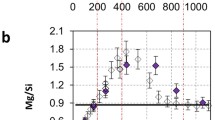Abstract
Three techniques have been used to determine what clay mineral surfaces are involved in the selective bonding of Co: (a) polyphosphate ions were used to block edge surfaces of montmorillonite and vermiculite from Co, (b) collapse of the interlamellar spaces with potassium saturation was used to block internal basal surfaces of vermiculite from Co, and (c) autoradiographs were prepared of vermiculite and mica particles that had reacted with Co58. In each case Co in low concentration was allowed to combine with the mineral in the presence of high concentrations of CaCl2.
The preliminary sorption of polyphosphate ions had no appreciable effect on the sorption of Co by the minerals studied, indicating that the edge surfaces were not likely to be involved in the Co reaction. The blocking of internal basal areas had only a very slight effect suggesting that these surfaces were involved in the sorption of Co, but only to a limited extent. Autoradiographs of naturally occurring vermiculite particles revealed a somewhat uneven distribution of Co over the planar surface of the particles. Removal of the outer layers of the crystals, either before or after the material had combined with Co but before autoradiography, resulted in a concentration of the metal along edges and cracks.
Apparently the external basal surfaces are principally involved in the specific sorption of Co by layer silicates. It is suggested that chemical weathering and physical abrasion of the surfaces introduce defect structures which favor the chemical bonding of heavy metals.
Similar content being viewed by others
References
Bower, C. A. and Truog, E. (1940) Base exchange capacity determination as influenced by nature of cation employed and formation of basic exchange salts: Soil Sci. Soc. Amer. Proc., v. 5, pp. 86–94.
Boyd, G. A. (1955) Autoradiography in Biology and Medicine: Academic Press, Inc., New York, 399 pp.
DeMumbrum, L. E. and Jackson, J. L. (1956) Infrared absorption evidence on exchange reaction mechanism of copper and zinc with layer silicate clays and peat: Soil Sci. Soc. Amer. Proc., v. 20, pp. 334–337.
Elgabaly, M. M. and Jenny, H. (1943) Cation and anion interchange with zinc montmorillonite clays: J. Phys. Chem., v. 47, pp. 399–408.
Hodgson, J. F. (1960) Cobalt reactions with montmorillonite: Soil Sci. Soc. Amer. Proc., v. 24, pp. 165–168.
Menzel, R. G. and Jackson, M. L. (1951) Mechanism of sorption of hydroxy cupric ion by clays: Soil Sci. Soc. Amer. Proc., v. 15, pp. 122–124.
Pelc, S. R. (1947) Autoradiograph technique: Nature, v. 160, pp. 749–750.
Spencer, W. F. and Gieseking, J. E. (1954) Cobalt adsorption and release in cation-exchange systems: Soil Sci., v. 78, pp. 267–276.
Tiller, Kevin G. (1961) Specific sorption of some heavy metal cations by pure minerals and soil clays: Ph. D. Thesis, Cornell University, Ithaca, N. Y.
Author information
Authors and Affiliations
Rights and permissions
About this article
Cite this article
Hodgson, J.F., Tiller, K.G. The Location of Bound Cobalt on 2:1 Layer Silicates. Clays Clay Miner. 9, 404–411 (1960). https://doi.org/10.1346/CCMN.1960.0090127
Published:
Issue Date:
DOI: https://doi.org/10.1346/CCMN.1960.0090127



